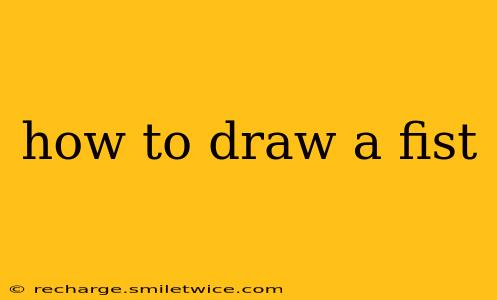How to Draw a Fist: A Step-by-Step Guide for Beginners and Beyond
Drawing a convincing fist might seem challenging, but with a little practice and the right techniques, you can master it. This guide will walk you through the process, from basic shapes to adding details and shading for a truly realistic portrayal. We'll cover various perspectives and styles, catering to both beginners and those looking to refine their skills.
What are the Basic Shapes Used to Draw a Fist?
The foundation of drawing a fist lies in simplifying its complex form into manageable shapes. Generally, you'll start with a combination of ovals, cylinders, and slightly flattened spheres to represent the knuckles, thumb, and overall hand structure. These basic shapes will then be refined and blended together to create the final form.
How Do I Draw a Closed Fist from the Side?
- Start with a simple oblong shape: This will form the base of your fist. Imagine a slightly flattened cylinder.
- Add the knuckles: Draw three slightly curved lines, representing the three main knuckles, atop the oblong shape. These lines shouldn't be perfectly straight; they curve naturally to follow the hand's anatomy.
- Sketch the thumb: Add a small, slightly curved cylinder or oval for the thumb, positioned at the base of the fist and slightly jutting out.
- Refine the shape: Gradually soften the harsh lines, blending the knuckles into the overall shape of the fist. Consider adding slight bulges to represent the muscles underneath the skin.
- Add details: Add subtle lines to suggest wrinkles and creases in the skin, paying attention to the tension and compression of the muscles. A slightly darker line along the knuckles can add depth.
How to Draw a Fist from the Front?
Drawing a fist from the front presents a different challenge.
- Begin with a square or slightly rounded square: This provides a good basis for the knuckles.
- Draw the knuckles: Create four slightly rounded knuckles at the top, arranged in a curve. Remember that knuckles aren't perfectly aligned; they're slightly staggered.
- Add the thumb: The thumb will be partially visible on the side, appearing as a slightly curved, thicker line.
- Shape the fist: Connect the knuckles to the sides, creating a slightly curved shape that narrows towards the wrist.
- Incorporate shading and details: Shading helps define the volume of the fist. Pay attention to the shadows between the knuckles to give it a three-dimensional feel. Add lines to suggest the texture of the skin.
How Do I Draw a Realistic Fist?
Achieving realism involves understanding anatomy and light and shadow.
- Study anatomical references: Look at images of real fists from various angles. Pay attention to the bone structure and the way the muscles bulge.
- Master shading techniques: Use different values of shading to create depth and volume. Observe how light falls on the fist and where the shadows are cast.
- Practice different perspectives: Don't just stick to one angle. Try drawing fists from various viewpoints to improve your understanding of form.
- Focus on details: Pay attention to small details like wrinkles, creases, and the subtle variations in skin texture. Adding these details brings your drawing to life.
What are Some Tips for Drawing Better Fists?
- Practice regularly: The more you draw, the better you'll become.
- Use references: Observe real-life hands and use photos as references.
- Experiment with different styles: Try cartoonish, realistic, or stylized approaches.
- Don't be afraid to make mistakes: Errors are part of the learning process.
- Have fun! Enjoy the creative process of drawing.
By following these steps and incorporating your own creative flair, you'll be well on your way to drawing impressive fists. Remember, practice is key! The more you draw, the more confident and skilled you will become.
